15 August 2011. Eating Sushi can be little intimidating, especially for the first timer. Even sushi-regulars can discover something new about the traditions. While no one will throw you out of the sushi bar for drinking sake with your nigiri, we hope that reading the following guidelines will calm your nerves and help you get the most out of your next visit to a sushi restaurant. 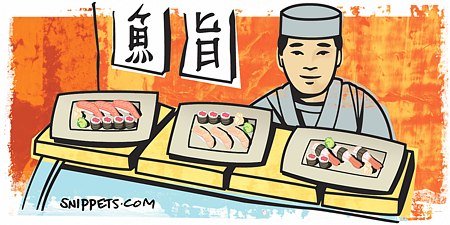
You don't have to restrict yourself to the menu. Ask your server if there are any seasonal options available.
Asking "What's fresh?" implies that the chef serves food that's not fresh, so it should probably be avoided.
If you go to the same sushi bar frequently, get to know the chef. If he knows what you like, he may recommend new or special dishes for you to try.
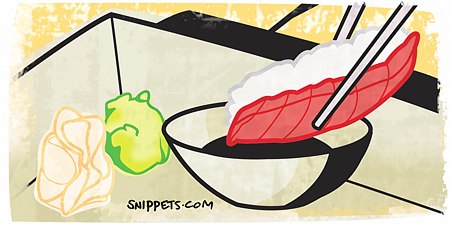
Dip the sushi fish side down into the soy sauce. This will also help prevent the rice from falling apart.
Only use a little soy and wasabi. You want to taste the fresh fish; don't overpower it with salt or heat.
Eat the sliced, pickled ginger between bites — it's there to cleanse your palate, not to flavor the bites.

Greet others, and show respect, by bowing, not a handshake.
You don't have to initiate a bow, but you should bow in return if someone bows to you.
A few rounds of bowing may occur. Go along with it; it's a sign of respect.

Eat sushi fish side down, not fish side up.
Each piece is supposed to be bite-size, but if the piece of sushi is too big, it's OK to take two bites.
If you do eat sushi in two bites, don't put the second half back on your plate or the communal plate.
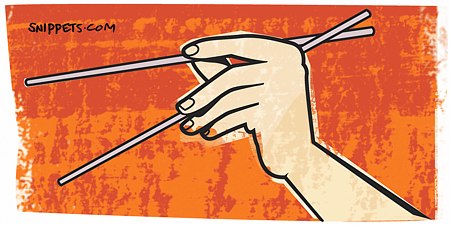
It's OK to use your fingers for most sushi! But, use your chopsticks for sashimi.
Don't mix your wasabi in your soy sauce. Add a little dab directly to the sushi if you want a little more heat.
When you take sushi from a shared plate, use the back end of your chopsticks — the end you don't put in your mouth.
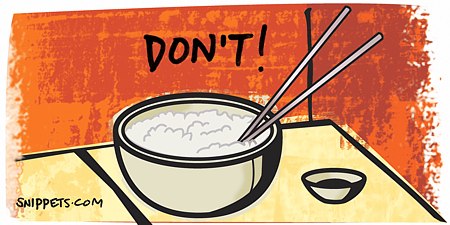
Don't store your chopsticks in your rice. This is how rice is offered to the deceased.
If you are not provided with a chopstick holder, rest your chopsticks on the edge of your plate with the tips pointed to the left.
Placing your chopsticks across your soy sauce bowl indicates that you have finished eating.
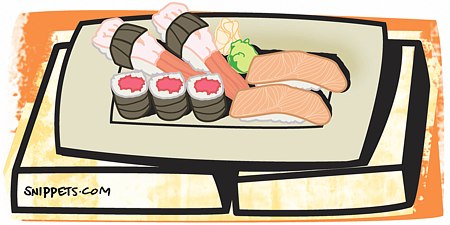
There are two main types of sushi — sushi rolls ("rolls" for short) and nigiri sushi ("sushi" for short).
Nigiri sushi is what most of us think of when we talk about sushi. It's a piece of fish (or other ingredient, like egg or octopus) on top of an oblong ball of rice.
Norimake are rolls that have seaweed on the outside. Uramaki are rolls that have rice on the outside. Temaki are hand rolls that come in the shape of a cone, not a cylinder.
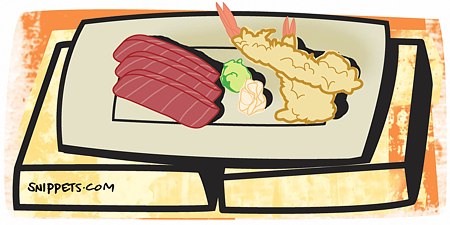
Sashimi and tempura are popular non-sushi items.
Sashimi is just a piece of raw fish without any rice.
Tempura is seafood (usually shrimp) or vegetables that have been battered and deep fried.

It's OK to drink your miso soup. Use the spoon or chopsticks to eat any larger pieces.
Traditionally, miso soup is served after the meal. In most Western restaurants, however, it is served first. If you want to go the traditional route, let your server know ahead of time.

Sake is a rice-based alcoholic beverage that can be served hot or cold. Typically, higher quality sake is served cold.
Sake is traditionally enjoyed with sashimi (not sushi), or by itself, before or after the meal.
When drinking sake with others, serve your companions, not yourself. They, in turn, should serve you.

You don't have to restrict yourself to the menu. Ask your server if there are any seasonal options available.
Asking "What's fresh?" implies that the chef serves food that's not fresh, so it should probably be avoided.
If you go to the same sushi bar frequently, get to know the chef. If he knows what you like, he may recommend new or special dishes for you to try.

Dip the sushi fish side down into the soy sauce. This will also help prevent the rice from falling apart.
Only use a little soy and wasabi. You want to taste the fresh fish; don't overpower it with salt or heat.
Eat the sliced, pickled ginger between bites — it's there to cleanse your palate, not to flavor the bites.

Greet others, and show respect, by bowing, not a handshake.
You don't have to initiate a bow, but you should bow in return if someone bows to you.
A few rounds of bowing may occur. Go along with it; it's a sign of respect.

Eat sushi fish side down, not fish side up.
Each piece is supposed to be bite-size, but if the piece of sushi is too big, it's OK to take two bites.
If you do eat sushi in two bites, don't put the second half back on your plate or the communal plate.

It's OK to use your fingers for most sushi! But, use your chopsticks for sashimi.
Don't mix your wasabi in your soy sauce. Add a little dab directly to the sushi if you want a little more heat.
When you take sushi from a shared plate, use the back end of your chopsticks — the end you don't put in your mouth.

Don't store your chopsticks in your rice. This is how rice is offered to the deceased.
If you are not provided with a chopstick holder, rest your chopsticks on the edge of your plate with the tips pointed to the left.
Placing your chopsticks across your soy sauce bowl indicates that you have finished eating.

There are two main types of sushi — sushi rolls ("rolls" for short) and nigiri sushi ("sushi" for short).
Nigiri sushi is what most of us think of when we talk about sushi. It's a piece of fish (or other ingredient, like egg or octopus) on top of an oblong ball of rice.
Norimake are rolls that have seaweed on the outside. Uramaki are rolls that have rice on the outside. Temaki are hand rolls that come in the shape of a cone, not a cylinder.

Sashimi and tempura are popular non-sushi items.
Sashimi is just a piece of raw fish without any rice.
Tempura is seafood (usually shrimp) or vegetables that have been battered and deep fried.

It's OK to drink your miso soup. Use the spoon or chopsticks to eat any larger pieces.
Traditionally, miso soup is served after the meal. In most Western restaurants, however, it is served first. If you want to go the traditional route, let your server know ahead of time.

Sake is a rice-based alcoholic beverage that can be served hot or cold. Typically, higher quality sake is served cold.
Sake is traditionally enjoyed with sashimi (not sushi), or by itself, before or after the meal.
When drinking sake with others, serve your companions, not yourself. They, in turn, should serve you.

 ), because I put wasabi AND ginger on my sushi, because I love the flavor combination. I like it so much that I keep powdered wasabi and pickled ginger in the house at all times. The buffet I frequent weekly has Sushi, Norimake and Uramaki all on the lunch buffet, along with steamed mussels, baked salmon and a plethora of other offerings to please my unsophisticated palette. All for $4.49 for AYCE. Dinner is $7.69 and has more fresh offerings on the raw bar as well as breaded shrimp and crab legs. I don't know how they do it for that price.
), because I put wasabi AND ginger on my sushi, because I love the flavor combination. I like it so much that I keep powdered wasabi and pickled ginger in the house at all times. The buffet I frequent weekly has Sushi, Norimake and Uramaki all on the lunch buffet, along with steamed mussels, baked salmon and a plethora of other offerings to please my unsophisticated palette. All for $4.49 for AYCE. Dinner is $7.69 and has more fresh offerings on the raw bar as well as breaded shrimp and crab legs. I don't know how they do it for that price.